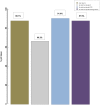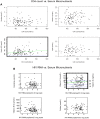Micronutrient deficiency and treatment adherence in a randomized controlled trial of micronutrient supplementation in ART-naïve persons with HIV
- PMID: 24465617
- PMCID: PMC3897458
- DOI: 10.1371/journal.pone.0085607
Micronutrient deficiency and treatment adherence in a randomized controlled trial of micronutrient supplementation in ART-naïve persons with HIV
Abstract
Introduction: The MAINTAIN study is an on-going RCT comparing high-dose micronutrient and anti-oxidant supplementation versus recommended daily allowance (RDA) vitamins in slowing HIV immune deficiency progression in ART-naïve people with HIV infection.
Objective: We planned analysis of the first 127 participants to determine the baseline prevalence of serum micronutrient deficiencies and correlates, as well as tolerance and adherence to study interventions.
Methods: Participants receive eight capsules twice daily of 1) high-dose or 2) RDA supplements for two years and are followed-up quarterly for measures of immune deficiency progression, safety and tolerability. Regression analysis was used to identify correlates of micronutrient levels at baseline. Adherence was measured by residual pill count, self-report using the General Treatment Scale (GTS) and short-term recall HIV Adherence Treatment Scale (HATS).
Results: Prior micronutrient supplementation (within 30 days) was 27% at screening and 10% of study population, and was not correlated with baseline micronutrient levels. Low levels were frequent for carotene (24%<1 nmol/L), vitamin D (24%<40 nmol/L) and serum folate (20%<15 nmol/L). The proportion with B12 deficiency (<133 pmol/L) was 2.4%. Lower baseline levels of B12 correlated lower baseline CD4 count (r = 0.21, p = 0.02) with a 21 pmol/L reduction in B12 per 100 cells/µL CD4. Vitamin D levels were higher in men (p<0.001). After a median follow-up of 1.63 years, there were 19 (15%) early withdrawals from the study treatment. Mean treatment adherence using pill count was 88%. Subjective adherence by the GTS was 81% and was moderately but significantly correlated with pill count (r = 0.29, p<0.001). Adherence based on short-term recall (HATS) was >80% in 75% of participants.
Conclusion: Micronutrient levels in asymptomatic HIV+ persons are in keeping with population norms, but micronutrient deficiencies are frequent. Adherence levels are high, and will permit a valid evaluation of treatment effects.
Trial registration: ClinicalTrials.gov NCT00798772.
Conflict of interest statement
Figures



Similar articles
-
A randomized control trial of high-dose micronutrient-antioxidant supplementation in healthy persons with untreated HIV infection.PLoS One. 2022 Jul 14;17(7):e0270590. doi: 10.1371/journal.pone.0270590. eCollection 2022. PLoS One. 2022. PMID: 35834528 Free PMC article. Clinical Trial.
-
Multiple micronutrient supplementation improves vitamin B₁₂ and folate concentrations of HIV infected children in Uganda: a randomized controlled trial.Nutr J. 2011 May 21;10:56. doi: 10.1186/1475-2891-10-56. Nutr J. 2011. PMID: 21600005 Free PMC article. Clinical Trial.
-
Folic acid supplementation and malaria susceptibility and severity among people taking antifolate antimalarial drugs in endemic areas.Cochrane Database Syst Rev. 2022 Feb 1;2(2022):CD014217. doi: 10.1002/14651858.CD014217. Cochrane Database Syst Rev. 2022. PMID: 36321557 Free PMC article.
-
Maternal B-vitamin and vitamin D status before, during, and after pregnancy and the influence of supplementation preconception and during pregnancy: Prespecified secondary analysis of the NiPPeR double-blind randomized controlled trial.PLoS Med. 2023 Dec 5;20(12):e1004260. doi: 10.1371/journal.pmed.1004260. eCollection 2023 Dec. PLoS Med. 2023. PMID: 38051700 Free PMC article. Clinical Trial.
-
Effects of micronutrients on placental function: evidence from clinical studies to animal models.Reproduction. 2018 Sep;156(3):R69-R82. doi: 10.1530/REP-18-0130. Epub 2018 May 29. Reproduction. 2018. PMID: 29844225 Review.
Cited by
-
Mapping MOS-HIV to HUI3 and EQ-5D-3L in Patients With HIV.MDM Policy Pract. 2017 Jul 3;2(2):2381468317716440. doi: 10.1177/2381468317716440. eCollection 2017 Jul-Dec. MDM Policy Pract. 2017. PMID: 30288427 Free PMC article.
-
Food insecurity among students living with HIV: Strengthening safety nets at the Nelson Mandela Metropolitan University, South Africa.SAHARA J. 2016 Dec;13(1):106-112. doi: 10.1080/17290376.2016.1218791. SAHARA J. 2016. PMID: 27687153 Free PMC article.
-
A randomized control trial of high-dose micronutrient-antioxidant supplementation in healthy persons with untreated HIV infection.PLoS One. 2022 Jul 14;17(7):e0270590. doi: 10.1371/journal.pone.0270590. eCollection 2022. PLoS One. 2022. PMID: 35834528 Free PMC article. Clinical Trial.
-
Micronutrient supplementation in adults with HIV infection.Cochrane Database Syst Rev. 2017 May 18;5(5):CD003650. doi: 10.1002/14651858.CD003650.pub4. Cochrane Database Syst Rev. 2017. PMID: 28518221 Free PMC article.
-
Innovative biomarkers TCN2 and LY6E can significantly inhibit respiratory syncytial virus infection.J Transl Med. 2024 Sep 23;22(1):854. doi: 10.1186/s12967-024-05677-8. J Transl Med. 2024. PMID: 39313785 Free PMC article.
References
-
- Dunbar-Jacob J, Erlen JA, Schlenk EA, Ryan CM, Sereika SM, et al.. (2000) Adherence in chronic disease. Annu Rev Nurs Res 18: 48–90. Available: http://www.ncbi.nlm.nih.gov/pubmed/10918932. Accessed 6 June 2013. - PubMed
-
- Wainberg MA, Friedland G (1998) Public health implications of antiretroviral therapy and HIV drug resistance. JAMA 279: 1977–1983. Available: http://www.ncbi.nlm.nih.gov/pubmed/9643862. Accessed 6 June 2013. - PubMed
-
- Altice FL, Friedland GH (1998) The era of adherence to HIV therapy. Ann Intern Med 129: 503–505. Available: http://www.ncbi.nlm.nih.gov/pubmed/9735090. Accessed 6 June 2013. - PubMed
-
- Szakacs TA, Wilson D, Cameron DW, Clark M, Kocheleff P, et al.. (2006) Adherence with isoniazid for prevention of tuberculosis among HIV-infected adults in South Africa. BMC Infect Dis 6: 97. Available: http://www.pubmedcentral.nih.gov/articlerender.fcgi?artid=1513236&tool=p.... Accessed 6 June 2013. - PMC - PubMed
-
- Balfour L, Kowal J, Silverman A, Tasca GA, Angel JB, et al.. (2006) A randomized controlled psycho-education intervention trial: Improving psychological readiness for successful HIV medication adherence and reducing depression before initiating HAART. AIDS Care 18: 830–838. Available: http://www.ncbi.nlm.nih.gov/pubmed/16971295. Accessed 6 June 2013. - PubMed
Publication types
MeSH terms
Substances
Associated data
Grants and funding
LinkOut - more resources
Full Text Sources
Other Literature Sources
Medical
Research Materials

